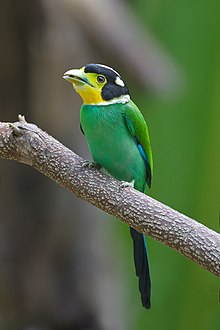Long-tailed broadbill
| Long-tailed broadbill | |
|---|---|

| |
| Scientific classification | |
| Domain: | Eukaryota |
| Kingdom: | Animalia |
| Phylum: | Chordata |
| Class: | Aves |
| Order: | Passeriformes |
| Family: | Eurylaimidae |
| Genus: | Psarisomus Swainson, 1837 |
| Species: | Psarisomus
|
| Binomial name | |
| Psarisomus Jameson, 1835
| |
The long-tailed broadbill (Psarisomus dalhousiae) is a species of broadbill that is found in the Himalayas, extending east through Northeastern India to Southeast Asia. It is the only bird in the genus Psarisomus. The long-tailed broadbill is about 25 cm (10 inches) in length and weighs between 50 and 60 grams. It can be identified by its shrill call.



The long-tailed broadbill is a forest bird that lives on insects. It is very sociable and normally travels in large, noisy parties except during the mating season. It builds a pear-shaped nest in a tree. The female usually lays between 5 and 6 eggs that are incubated by both sexes; both sexes also help to feed the young.
The scientific name commemorates Christina Broun, Countess of Dalhousie (1786–1839), wife of George Ramsay, 9th Earl of Dalhousie.

